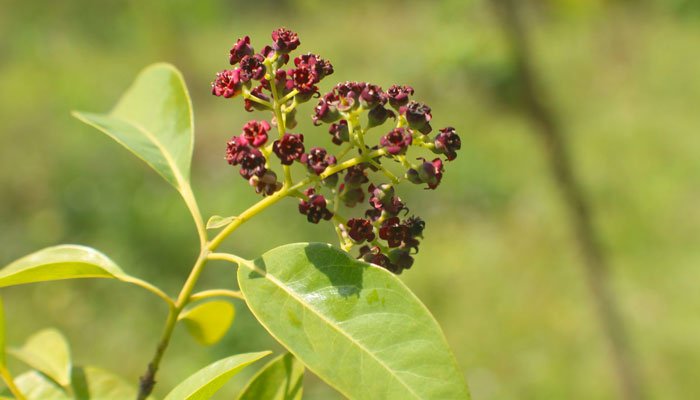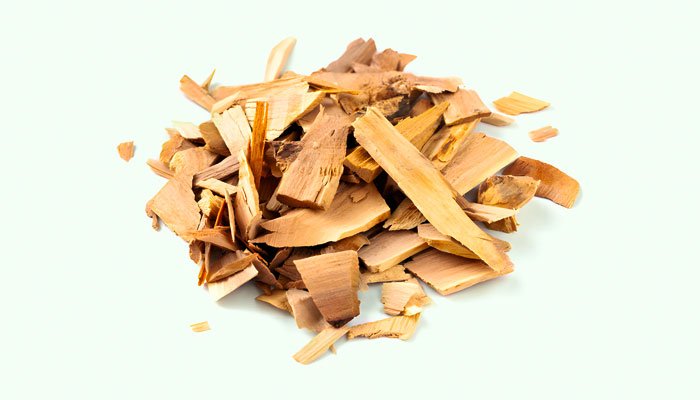What Is Tan Xiang
Tan Xiang commonly known as Sandalwood or Lignum Santali Albi is the heartwood of the trunk of Santalum album L., which is a small evergreen tree belonging to the family Santalaceae. It is a relatively practical and common Chinese herbal medicine, which first appeared in <Mingyi Bie Lu> during the Northern and Southern Dynasties (420-589 CE).
There are approximately 19 species of Santalum, which are distributed throughout southeastern Asia, Australia, and the islands of the South Pacific. The members of the genus are generally trees or shrubs. The plant is obligate hemiparasite attaching itself by haustoria to establish contact with the host and extracts xylem sap for nutrients and water.
Plants of this genus have high economic value. Their essential oils are known as “liquid gold” and can be used to make perfumes, soaps, incense, and traditional medicines. Among them, the most famous are S. album and S. acuminatum.
S. album commonly known as White sandalwood or Indian sandalwood is a tropical tree. They are originally from the Pacific Islands and are mainly distributed in Australia, Belgium, Cambodia, China, Germany, India, Indonesia, Japan, Madagascar, Malaysia, the Netherlands, Norway, Spain, Sri Lanka, Switzerland, the United Kingdom, and the United States. They are suitable for growing in areas between 23-35°C and rainfall between 600-1600 mm.

In summer, people cut down S. album and gather their trunks, remove their sapwood and impurities, take out the heartwood, chop them into small pieces, dry them in the shade, and make them into traditional Chinese medicines.
Tan Xiang contains santalol, exo-norbicycloekasantalal, β-santalic, teresantalic, nortricycloekasantalic, bicycloekasantalic, di-hydro-β-santalic acids, urs-12-en-3b-il-palmitate, bisabolenol A~E, tricycloekasan-talol, α-santalene, β-santalene, trans-α-bergamotene, α-curcumone, nuciferol, l-allohydroxiproline, betulinic acid, oleic acid, palmitic acid, gallic acid, anthocyanin, cyanidin 3-glucoside, terpenoids, saponins, flavan-3-ols, β-sitosterol, stigmasterol, and δ-5-avenasterol.
Generally, people prefer Tan Xiang that is grayish-yellow or yellow-brown in color, solid and difficult to break, with a brownish-yellow cross-section and oil traces. The best Tan Xiang has a strong fragrance when burned.
According to the Chinese Pharmacopoeia, the medicinal nature of Tan Xiang is relatively warm, with a pungent taste. It has a certain therapeutic effect on the pathological changes of the spleen, stomach, heart, and lung meridians.
In traditional Chinese medicine, it is often used to promote qi circulation and warm middle energizer, whet the appetite and relieve pain, and treat chest tightness, pain in the precordial region of the heart, abdominal distension, abdominal pain, poor appetite, vomiting, superficial gastritis, atrophic gastritis, functional dyspepsia, enteritis, dysentery, infantile convulsions, seborrheic dermatitis, angina pectoris, chest pain due to trauma, dysmenorrhea, and hyperlipidemia.
There are more than 50 kinds of traditional Chinese medicine prescriptions that contain it, such as Dan Shen Yin, Ren Shen Zai Zao Wan, and Su He Xiang Wan.
Benefits
- Anti-oxidation, reduced hepatic lipid peroxide content in d-galactose-mediated oxidative stress-induced mice [1].
- Anti-virus, inhibited herpes simplex virus-1 and -2 activity and influenza virus H3N2 replication [2].
- Lowering blood glucose, total cholesterol, low-density lipoprotein, and triglyceride levels induced by streptozotocin in diabetic rats, and increasing the high-density lipoprotein levels [3].
- Promoting qi circulation and warming middle energizer, treating chest tightness, precordial pain with chest discomfort, and cold pain in the abdomen caused by qi stagnation due to congealing cold.
- Whetting the appetite and relieving pain, treating cold pain in the epigastric area or abdomen, abdominal fullness and distention, anorexia, and vomiting.
- Its methanol extract can inhibit castor oil-induced diarrhea in mice. It also has inhibitory effects on gastric emptying and small intestine motility induced by neostigmine in mice. In addition, it has a dose-dependent inhibitory effect on spontaneous contractions of isolated jejunum in rats and can also relax contractions induced by Ach, 5-HT, and K(+). [4].
- Its essential oil has a good therapeutic effect on cutaneous viral warts caused by human papillomavirus [5].
- Its essential oil is genotoxic and capable of inducing DNA single- and double-strand breaks in MCF-7 cells [6]. In addition, studies have shown that it can induce cell-cycle arrest and apoptosis in skin cancer, breast cancer, and prostate cancer cells [7].
- Its extract was capable to attenuate polyinosnic-polycytidylic acid-induced neuroinflammatory effect through the induction of TLR2, TLR4 and the modulation of TLR negative regulators of the TRAF3, IRF3, and NF-κB pathways [8].
- Its extract was reported to inhibit cardiac tissue damage via reduction of lipid peroxidation damage on the doxorubicin-induced cardiotoxicity rat model and a significant protective effect against induced myocardial infarction in albino rats in a dose-dependent manner [9].
- Its essential oil has a certain inhibitory effect on Gram-positive bacteria (including Micrococcus glutamicus, Micrococcus flavus, Sarcina lutea, Propionobacterium acnes, Staphylococcus albus, Staphylococcus aureus, MRSA, Staphylococcus epidermidis, Streptococcus equisimilis, and Streptococcus pyogenes), Gram-negative bacteria (including Acinetobacter baumannii, Acinetobacter calcoaceticus, Klebsiella aerogenes, Klebsiella pneumoniae, Pseudomonas aeruginosa, Pseudomonas florescens, and Pseudomonas putida), Yeast (Candida albicans and Candida krusei), and fungi (including Epidermophyton floccosum, Epidermophyton inguinale, Microsporum canis, Microsporum gypseum, Trichophyton asteroids, Trichophyton interdigitale, Trichophyton mentagrophytes, and Trichophyton purpureum) [2].
Combinations
- It can be used in combination with Bai Dou Kou (Fructus Amomi Rotundus), Sha Ren (Fructus Amomi), Ding Xiang (Flos Caryophylli), etc. to treat chest tightness caused by qi stagnation due to congealing cold.
- It can be used in combination with Bi Bo (Fructus Piperis Longi), Yan Hu Suo (Rhizoma Corydalis), Gao Liang Jiang (Rhizoma Alpiniae Officinarum), etc. to treat precordial pain with chest discomfort caused by qi stagnation due to congealing cold.
- It can be used in combination with Chen Xiang (Aquilariae Lignum Resinatum), Bai Dou Kou (Fructus Amomi Rotundus), Sha Ren (Fructus Amomi), etc. to treat cold pain in the epigastric area, vomiting, and poor appetite.
- It can be used in combination with Dan Shen (Radix et Rhizoma Salviae Miltiorrhizae) and Sha Ren (Fructus Amomi) to treat stabbing pain in the heart and chest, epigastric pain caused by blood stasis and qi stagnation.
- It can be used in combination with Ma Huang (Herba Ephedrae), Qiang Huo (Rhizoma et Radix Notopterygii), Sheng Ma (Rhizoma Cimicifugae), Bai Ji (Rhizoma Bletillae), Fang Feng (Radix Saposhnikoviae), and Dang Gui (Radix Angelicae Sinensis) to treat seborrheic dermatitis.
Side Effects
- Its volatile oil and its major constituent have low acute oral and dermal toxicity in laboratory animals. Occasional cases of irritation or sensitization reactions to its volatile oil in humans are reported in the literature [10].
Precautions and Warnings
- The dosage of Tan Xiang should be controlled between 2-5g.
- It can be made into decoctions, pills, powders, sprays, or ground for external use.
- When preparing a decoction containing Tan Xiang, it is recommended to first decoct the other herbs and then add them toward the end of the boiling process.
- People who are allergic to Tan Xiang should not take it.
- Patients with hyperactivity of fire due to yin deficiency should not take it.
- Patients with hematemesis or nasal bleeding due to sthenic fever should not take it.
- Pregnant and lactating women, children, and elderly individuals with the weak constitution should take it under the guidance of a doctor.
